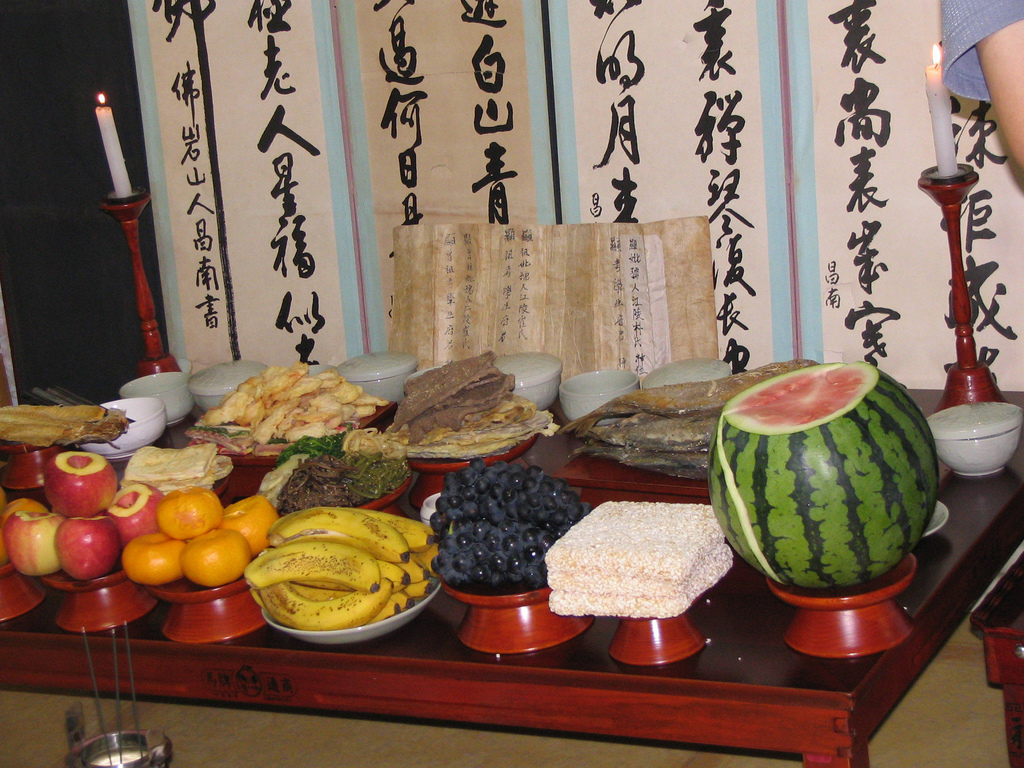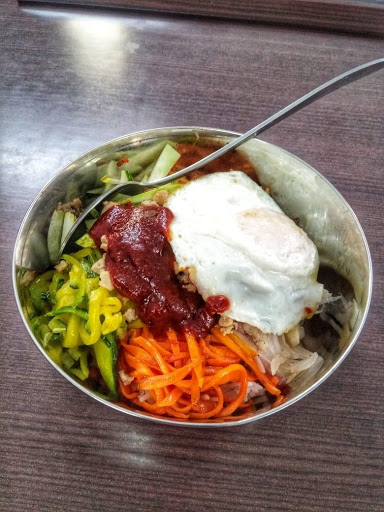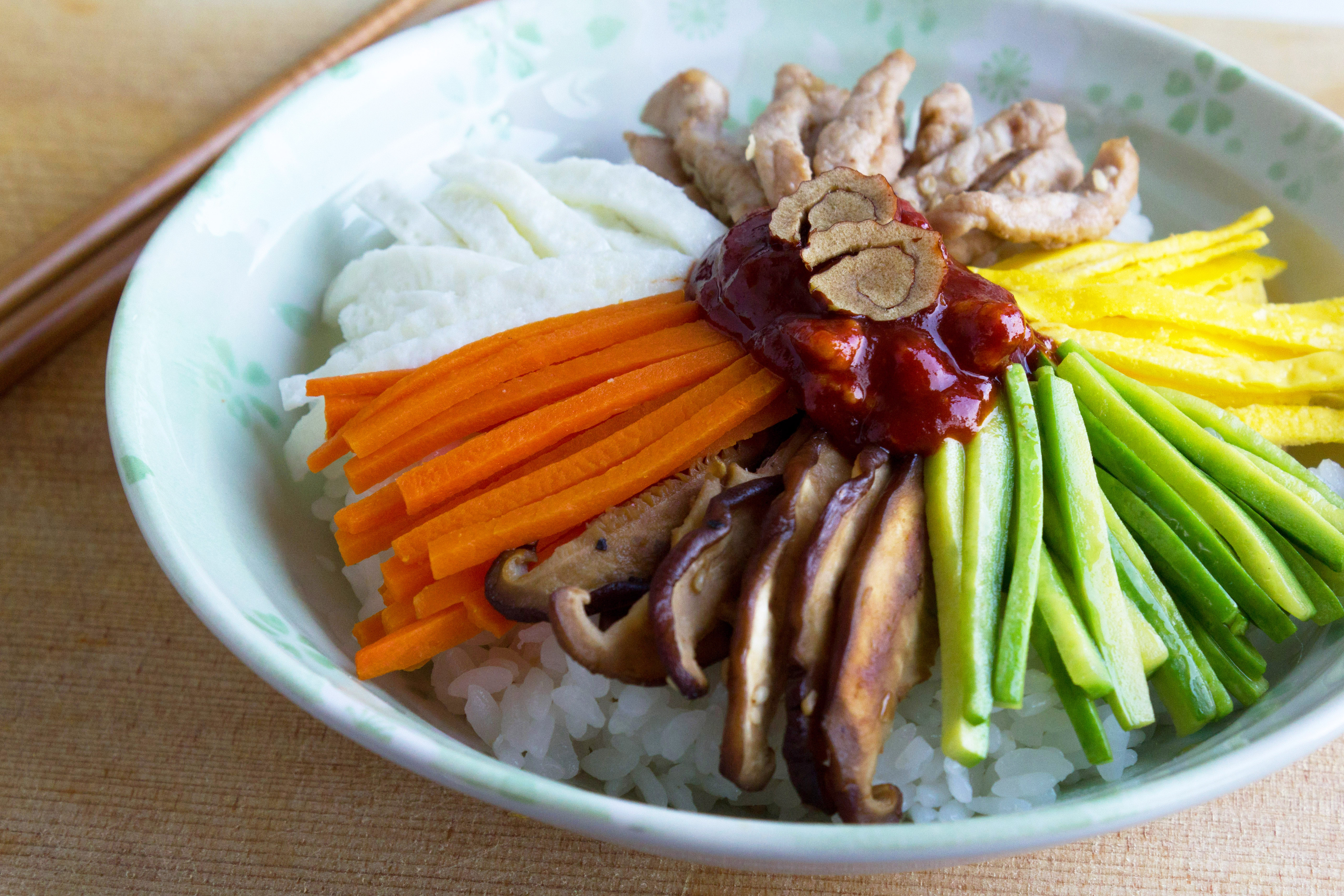|
Heotjesatbap
''Heotjesatbap'' (, also spelled ''heotjesabap''), a traditional Korean dish, is a variety of ''bibimbap'', served with soy sauce (''ganjang'') instead of the ''gochujang'' (hot pepper paste) that is more commonly used. ''Heotjesabap'' consists of mainly several types of ''namul'' (young sprouted vegetables) over white rice. It is also served with grilled fish and some '' jeon'' (Korean pancake). The term ''Heotjesa bap'' literally means "mock jesa meal", with jesa being Korean death anniversary ceremonies, during which the living relatives of the deceased prepare and offer a variety of dishes to the spirits of their departed ancestors and relatives. In most modern jesa, the feast is offered to the ancestors through a ceremony involving different family members placing dishes of food on the table and pouring rice wine into cups, as gracious hosts would do for their guests. After the food and drink is set out in a specific order, the family members leave the room to give the spir ... [...More Info...] [...Related Items...] OR: [Wikipedia] [Google] [Baidu] |
Jesa
''Jesa'' (, ) is a ceremony commonly practiced in Korea. Jesa functions as a Ancestor veneration, memorial to the ancestors of the participants. Jesa are usually held on the anniversary of the ancestor's death. The majority of Catholic Church in South Korea, Catholics, Korean Buddhism, Buddhists and Irreligion in South Korea, nonbelievers practice ancestral rites, although National Council of Churches in Korea, Protestants do not. Since their origins, Jesa has taken on a certain formality as human civilization has developed, which is sometimes called rituals in Confucianism. The Catholic ban on ancestral rituals was lifted in 1939, when Pope Pius XII formally recognized ancestral rites as a civil practice (see also Chinese Rites controversy). Many Korean Protestants no longer practice this rite and avoid it both locally and Korean diaspora, overseas. Jesa Rituals: A Continuation from the Dangun Era in Korean Culture The ancestral rituals known as Jesa in Korean, have been pr ... [...More Info...] [...Related Items...] OR: [Wikipedia] [Google] [Baidu] |
Korean Cuisine
Korean cuisine is the set of foods and culinary styles which are associated with Korean culture. This cuisine has evolved through centuries of social and political change. Originating from ancient Prehistoric Korea, agricultural and nomadic traditions in Korea and southern Manchuria, Korean cuisine reflects a complex interaction of the natural environment and different cultural trends. Korean cuisine is largely based on rice, vegetables, seafood and (at least in South Korea) meats. Dairy is largely absent from the traditional Korean diet. Traditional Korean meals are named for the number of side dishes () that accompany steaming, steam-cooked short-grain rice. Kimchi is served at nearly every meal. Commonly used ingredients include sesame oil, (fermented bean paste), Korean soy sauce, soy sauce, salt, garlic, ginger, (chili pepper, pepper flakes), (fermented red chili paste) and napa cabbage. Ingredients and dishes vary by province. Many regional dishes have become nat ... [...More Info...] [...Related Items...] OR: [Wikipedia] [Google] [Baidu] |
Andong
Andong () is a Administrative divisions of South Korea, city in South Korea, and the capital of North Gyeongsang Province. It is the largest city in the northern part of the province with a population of 167,821 as of October 2010. The Nakdong River flows through the city. Andong is a market centre for the surrounding agricultural areas. Since the 1970s Andong has developed rapidly, although the population has fallen by nearly seventy thousand as people have moved away to Seoul, Busan, Daegu and other urban centres. In the late 1990s and early 2000s it became a tourism and cultural center. Andong is known as a centre of culture and folk traditions. The surrounding area maintains many types of traditions and the Andong Folk Festival is held in mid October every year. One of the most famous aspects of these cultural festivities are the Andong masks. Andong National University, specialising in education and Korean folklore, has grown rapidly since the 1970s. Other tertiary institut ... [...More Info...] [...Related Items...] OR: [Wikipedia] [Google] [Baidu] |
Bibimbap
Bibimbap * ( ; ), sometimes Romanization of Korean, romanised as bi bim bap or bi bim bop, is a Korean rice dish. The term ''bibim'' means "mixing" and ''Bap (rice dish), bap'' is cooked rice. It is served as a bowl of warm white rice topped with ''namul'' (sautéed or blanched seasoned vegetables) and ''gochujang'' (chili pepper paste). Egg and sliced meat (usually beef) are common additions, stirred together thoroughly just before eating. In South Korea, some cities such as Jeonju, Jinju, and Tongyeong are known for their versions of bibimbap. In 2017 the dish was listed at number 40 on the ''World's 50 most delicious foods'' readers' poll compiled by CNN Travel. Etymologies ''Bibimbap'' has gone by a number of names over time. Its earliest names appear in Korean hanja texts. Its first name was ' (). This name appeared in the ''Yeokjogumun'' () portion of the book ''Historical Notes of Gijae'' (), which was written by Bak Dongnyang () around 1590. In the ''Cheongdae ilgi ... [...More Info...] [...Related Items...] OR: [Wikipedia] [Google] [Baidu] |
Yangban
The ''yangban'' () were part of the traditional ruling class or gentry of dynastic Korea during the Joseon period. The ''yangban'' were mainly composed of highly educated civil officials and military officers—landed or unlanded aristocrats who individually exemplified the Korean Confucian form of a " scholarly official". They were largely government administrators and bureaucrats who oversaw medieval and early modern Korea's traditional agrarian bureaucracy until the end of the dynasty in 1897. In a broader sense, an office holder's family and descendants, as well as country families who claimed such descent, were socially accepted as ''yangban''. In contemporary Korean language, the term ''yangban'' can be used either as a compliment or insult. Etymology ''Yangban'' literally means "two branches" of administration: ''munban'' () which comprises civil administrators and ''muban'' () which comprises martial office holders. The term yangban first appeared sometime during late ... [...More Info...] [...Related Items...] OR: [Wikipedia] [Google] [Baidu] |
Joseon
Joseon ( ; ; also romanized as ''Chosun''), officially Great Joseon (), was a dynastic kingdom of Korea that existed for 505 years. It was founded by Taejo of Joseon in July 1392 and replaced by the Korean Empire in October 1897. The kingdom was founded following the aftermath of the overthrow of Goryeo in what is today the city of Kaesong. Early on, Korea was retitled and the capital was relocated to modern-day Seoul. The kingdom's northernmost borders were expanded to the natural boundaries at the rivers of Yalu River, Amnok and Tumen River, Tuman through the subjugation of the Jurchen people, Jurchens. During its 500-year duration, Joseon encouraged the entrenchment of Korean Confucianism, Confucian ideals and doctrines in Korean society. Neo-Confucianism was installed as the new state's ideology. Korean Buddhism, Buddhism was accordingly discouraged, and occasionally Buddhists faced persecution. Joseon consolidated its effective rule over the Korean peninsula and saw the he ... [...More Info...] [...Related Items...] OR: [Wikipedia] [Google] [Baidu] |
Seonbi
''Seonbi'' () were scholars during the Goryeo and Joseon periods of Korean history. They were generally seen as non-governmental servants of the public, who chose to pass on the benefits and authority of official power in order to develop and share knowledge. However, some former bureaucrats were seen as ''seonbi'', as they moved to the countryside after retirement and adopted the ''seonbi'' lifestyle. ''Seonbi'' in the traditional sense do not exist today, although the term is sometimes used metaphorically to describe people. When applied to a person, the meaning can be complimentary, highlighting a person's intelligence, morality, and composure. However, young South Koreans who tend to have low opinions of the Joseon Dynasty or Confucianism, tend to use the word ''ssib seonbi'' in a derogatory way, or just call them seonbi (this is more frequent today). It is used similarly to the English term "geezer", or to highlight a perceived anachronistic value system. Philosophy The seo ... [...More Info...] [...Related Items...] OR: [Wikipedia] [Google] [Baidu] |
North Gyeongsang Province
North Gyeongsang Province (, ) is a province in eastern South Korea, and with an area of , it is the largest province in the Korean peninsula. The province was formed in 1896 from the northern half of the former Gyeongsang province, and remained a province of Korea (as Keishōhoku-dō during Japanese rule) until the country's division in 1945, then became part of South Korea. Daegu was the capital of North Gyeongsang Province between 1896 and 1981, but has not been a part of the province since 1981. In 2016, the provincial capital moved from Daegu to Andong. History The 1,000-year-old Silla Kingdom flourished and unified the previous three kingdoms. The area was named Gyeongsang-do in 1314 during the Goryeo Dynasty. In 1896, during the Joseon Dynasty, the area was renamed Gyeongsangbuk-do as 13 roads were reorganized. The current administrative district was reorganized with the reorganization of Bu, Gun, and Myeon in 1914. Geography and climate The province is part of the ... [...More Info...] [...Related Items...] OR: [Wikipedia] [Google] [Baidu] |
Rice Wine
Rice wine is an alcoholic beverage fermentation, fermented from rice, traditionally consumed in East Asia, Southeast Asia and South Asia, where rice is a quintessential staple crop. Rice wine is made by the fermentation of rice starch, during which microbes enzyme, enzymatically convert polysaccharides to sugar and then to ethanol. The Chinese ''mijiu'' (most famous being ''huangjiu''), Japanese ''sake'', and Korean ''cheongju (beverage), cheongju'', ''dansul'' and ''takju'' are some of the most notable types of rice wine. Rice wine typically has an alcohol content of 10–25% alcohol by volume, ABV, and is typically served warm. One panel of taste testers arrived at as an optimum serving temperature. Rice wines are drunk as a wine and food pairing, dining beverage in East Asian, Southeast Asian and South Asian cuisine during formal dinners and banquets, and are also used as cooking wines to flavoring, add flavors or to neutralize unwanted tastes in certain food items (e.g. sea ... [...More Info...] [...Related Items...] OR: [Wikipedia] [Google] [Baidu] |
Bibimbap
Bibimbap * ( ; ), sometimes Romanization of Korean, romanised as bi bim bap or bi bim bop, is a Korean rice dish. The term ''bibim'' means "mixing" and ''Bap (rice dish), bap'' is cooked rice. It is served as a bowl of warm white rice topped with ''namul'' (sautéed or blanched seasoned vegetables) and ''gochujang'' (chili pepper paste). Egg and sliced meat (usually beef) are common additions, stirred together thoroughly just before eating. In South Korea, some cities such as Jeonju, Jinju, and Tongyeong are known for their versions of bibimbap. In 2017 the dish was listed at number 40 on the ''World's 50 most delicious foods'' readers' poll compiled by CNN Travel. Etymologies ''Bibimbap'' has gone by a number of names over time. Its earliest names appear in Korean hanja texts. Its first name was ' (). This name appeared in the ''Yeokjogumun'' () portion of the book ''Historical Notes of Gijae'' (), which was written by Bak Dongnyang () around 1590. In the ''Cheongdae ilgi ... [...More Info...] [...Related Items...] OR: [Wikipedia] [Google] [Baidu] |







